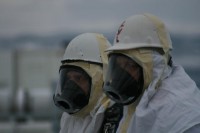Blog post by Theresa Labriola, Riverkeeper’s Hanford Coordinator—
Last week, the U.S. Department of Energy (Energy) released two major decisions detailing how they will clean up Hanford. One dealt with the 56 million gallons of nuclear waste stored in underground tanks. The other addressed the 40 square mile 300 Area, where uranium was processed, which abuts the Hanford Reach. Both plans fail to adequately protect human health and the environment.

Here's the short story.
According to the tank closure decision, Energy will remove 99 percent of the nuclear and chemical waste from the underground tanks. The problem is that this leaves more than 500,000 gallons of nuclear waste along with the carcass of 177 storage tanks in the ground, forever. Energy will then fill the tanks with grout and cover the site with dirt. This plan will lead to recontamination of the groundwater resource under Hanford for tens of thousands of years.
According to the second decision, Energy will use experimental technology to bind uranium to the soil in the 300 Area, on the southeast corner of the site. If this fails, uranium will naturally attenuate or dilute into the Columbia River, leaving the health of our communities and natural resources exposed. Although Energy received hundreds of comments from stakeholders and Tribes asking them to take proactive measures to remove, treat, and dispose of contaminated soil in the 300 Area. Energy refused.
Energy is sidestepping its responsibility to protect human health and the environment from Hanford's nuclear and chemical waste. In the next few weeks, we'll dig into these decisions further, and let you know how you can help us restore Hanford.



